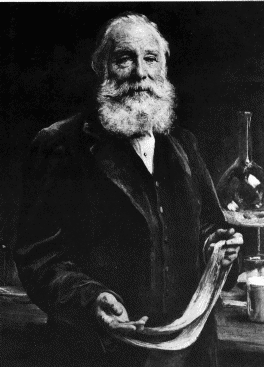
William Henry Perkin (1838-1907)
The career of Sir William Henry Perkin was initiated by one of the most fortuitous discoveries in the history of chemistry. He did not realize his goal, but his curiosity led to financial success.
Perkin was a student at the City of London Day School where he was influenced by Mr. Thomas Hall, a former student of Hofmann at the Royal College of Chemistry . In spite of Perkin senior's desire for his son to become an architect [for an architect turned chemist, see August Kekule], several meetings with Hall set the course for Perkin's future career as a chemist.
Perkin entered the Royal College at the tender age of fifteen in 1853. Because Perkin was otherwise engaged during the day in research at the College, he set up a home laboratory where he was able to conduct his own work in the evening and during vacation. In 1849, Hofmann had suggested how certain coal tar products could be converted into alkaloids (base-like, i.e., amines). As a consequence, the synthesis of the naturally occurring alkaloid, quinine, from the bark of the cinchona tree was offered as a challenging and worthwhile undertaking. During the Easter recess of 1856, young Perkin decided to synthesize quinine. [In 1856, there was no idea of how atoms were connected (structure) nor agreement on the combining masses of atoms. This challenge may have stimulated Perkin at this time because England was engaged in the Crimean War (1854-1856). The British Empire was undoubtedly a user of quinine to combat malaria. Quinine was not synthesized until 1944 by Doering and Woodward during World War II. The motivation for the synthesis was to provide a source of quinine for the manufacture of polarizers. ]
By simply balancing the masses of an equation, Perkin thought that two allyltoluidines (C10H12N) upon oxidation with three oxygen atoms (potassium chromate) would give quinine (C20H21N2O2) and one water. He did not obtain quinine but rather a dirty dark brown precipitate. To simplify the experiment, he oxidized aniline sulfate with potassium dichromate. Once again a dark precipitate was obtained. Extraction of the precipitate with alcohol gave a purple dye he named Tyrian Purple, and later named mauve (mauveine) by the French. Purple dyes were popular at the time but were unfortunately made from lichens and bat guano. They also were not fast, i.e., they faded rapidly. Mauve proved to be both fast and brilliant. The British stamp, the "pennyred" was dyed with mauve. Perkin received a patent in 1865 for his invention, left the Royal College, (much to Hofmann's displeasure), and established a factory to manufacture mauve, and eventually, many other dyes.
Benzene was obtained by the distillation of coal tar as the raw material for the manufacture of mauve. The distillate, as it was to turn out, was contaminated wth toluene. Thus, nitration (sodium nitrate and sulfuric acid) and reduction (iron and acetic acid) gave a mixture of aniline, o- and p-toluidine. The structure of mauve was corrected in 1994 and found to be a mixture of mauveine A (major component) and mauveine B (minor component). Where are the aniline, o- and p-toludine residues in these structures?